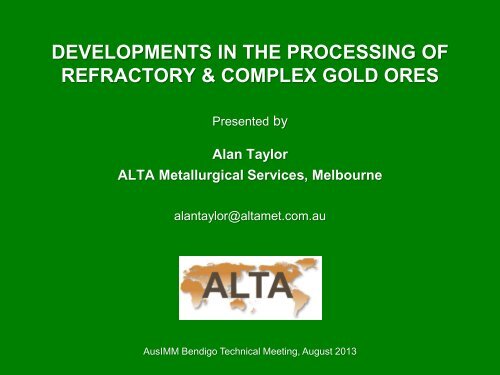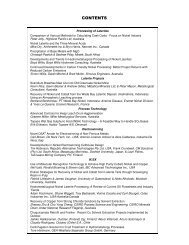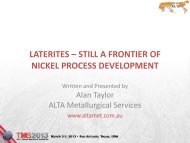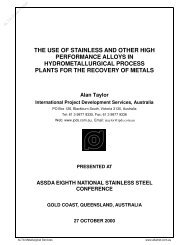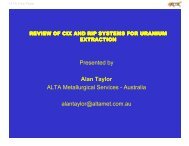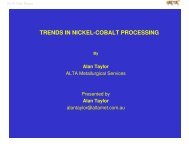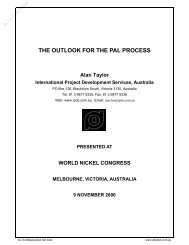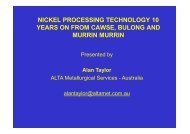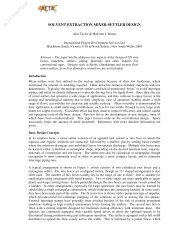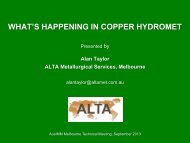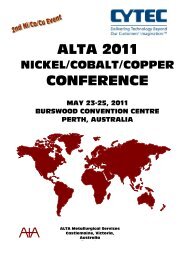developments in the processing of refractory & complex gold ores
developments in the processing of refractory & complex gold ores
developments in the processing of refractory & complex gold ores
Create successful ePaper yourself
Turn your PDF publications into a flip-book with our unique Google optimized e-Paper software.
DEVELOPMENTS IN THE PROCESSING OF<br />
REFRACTORY & COMPLEX GOLD ORES<br />
Presented by<br />
Alan Taylor<br />
ALTA Metallurgical Services, Melbourne<br />
alantaylor@altamet.com.au<br />
AusIMM Bendigo Technical Meet<strong>in</strong>g, August 2013
INTRODUCTION<br />
The <strong>in</strong>creas<strong>in</strong>g trend towards lower grade and more <strong>complex</strong> <strong>ores</strong><br />
and <strong>the</strong> need for lower cost processes especially for small deposits<br />
have resulted <strong>in</strong> <strong>the</strong> <strong>in</strong>troduction <strong>of</strong> a variety <strong>of</strong> new processes<br />
which are at various stages <strong>of</strong> development.<br />
Additional <strong>in</strong>centives <strong>in</strong>clude <strong>in</strong>creas<strong>in</strong>g environmental pressure<br />
aga<strong>in</strong>st <strong>the</strong> use <strong>of</strong> cyanide, concern over <strong>the</strong> release <strong>of</strong> toxic<br />
elements and <strong>the</strong> need to conserve water resources.<br />
2
• Ores conta<strong>in</strong><strong>in</strong>g <strong>gold</strong> locked <strong>in</strong> solid solution or as f<strong>in</strong>e<br />
<strong>in</strong>clusions <strong>in</strong>clude:<br />
- iron/arsenic sulphide m<strong>in</strong>erals such as arsenopyrite, arsenian<br />
pyrite, and pyrite<br />
- copper sulphides such as chalcopyrite, tetrahedrite<br />
- none sulphide gangue m<strong>in</strong>erals such as silica m<strong>in</strong>erals, iron<br />
oxides<br />
• Ores with <strong>in</strong>soluble or slow leach<strong>in</strong>g <strong>gold</strong> m<strong>in</strong>erals <strong>in</strong>clud<strong>in</strong>g:<br />
– <strong>gold</strong> tellurides<br />
– aurostibnite – AuSb 2<br />
– Maldonite – Au 2 Bi<br />
ORE CATEGORIES<br />
– Fischesserite - Ag 3 AuSe 2<br />
• Ores conta<strong>in</strong><strong>in</strong>g preg-robb<strong>in</strong>g constituents such carbonaceous<br />
material or clays.<br />
3
ORE CATEGORIES (CONT.)<br />
• Ores conta<strong>in</strong><strong>in</strong>g cyanide and/or oxygen consumers <strong>in</strong>clud<strong>in</strong>g:<br />
- oxide/hydroxide copper m<strong>in</strong>erals, native copper, secondary<br />
copper sulphide m<strong>in</strong>erals<br />
- reactive iron sulphide m<strong>in</strong>erals, pyrrhotite, marcasite<br />
- reactive antimony and arsenic sulphide m<strong>in</strong>erals,<br />
stibnite Sb 2 S 3 , orpiment As 2 S 3 , realgar As 4 S 4<br />
Note:<br />
More than one category can apply to a particular ore deposit;<br />
e.g. double <strong>refractory</strong> <strong>ores</strong> <strong>in</strong> Nevada with <strong>gold</strong> locked <strong>in</strong> iron<br />
sulphides plus preg-robb<strong>in</strong>g carbonaceous material.<br />
4
Note: covellite solubility is similar to chalcocite.<br />
(Ref: “Cyanamid wants you to know”, May 1955)<br />
5
TREATMENT PROCESSES<br />
6
LOCKED GOLD<br />
Iron/Arsenic Sulphides - pretreatment processes <strong>in</strong>clude:<br />
• Roast<strong>in</strong>g <strong>of</strong> whole ore or flotation concentrate.<br />
• Low pressure <strong>in</strong>tensive oxidation.<br />
• Acid or alkal<strong>in</strong>e pressure oxidation <strong>of</strong> whole ore or flotation<br />
concentrate.<br />
• Bio-oxidation <strong>of</strong> flotation concentrate.<br />
• F<strong>in</strong>e or ultraf<strong>in</strong>e gr<strong>in</strong>d<strong>in</strong>g <strong>of</strong> flotation concentrate followed by<br />
direct cyanidation or one <strong>of</strong> <strong>the</strong> above pretreatment processes.<br />
• Heap bio-oxidation <strong>of</strong> whole ore or flotation concentrate.<br />
Copper Sulphides – flotation followed by smelt<strong>in</strong>g, roast<strong>in</strong>g or<br />
hydromet treatment <strong>of</strong> concentrate.<br />
Non-Sulphide Gangue M<strong>in</strong>erals – f<strong>in</strong>e gr<strong>in</strong>d<strong>in</strong>g <strong>of</strong> whole ore<br />
followed by direct cyanidation.<br />
7
INSOLUBLE OR SLOW LEACHING GOLD MINERALS<br />
• Roast<strong>in</strong>g <strong>of</strong> flotation concentrate followed by cyanidation.<br />
• Alkal<strong>in</strong>e chlor<strong>in</strong>ation leach<strong>in</strong>g <strong>of</strong> flotation concentrate followed<br />
by cyanidation.<br />
• Low pressure cyanidation <strong>of</strong> flotation concentrate.<br />
8
Oxidised or Low Sulphide Ores<br />
PREG-ROBBING ORES<br />
• Maximization <strong>of</strong> <strong>gold</strong> recovery by gravity plus <strong>in</strong>tensive<br />
cyanidation <strong>of</strong> concentrate.<br />
• Application <strong>of</strong> CIL with high carbon concentration.<br />
• Addition <strong>of</strong> kerosene or o<strong>the</strong>r substance to blanket <strong>the</strong> pregrobb<strong>in</strong>g<br />
material followed by CIL or RIL (not subject to foul<strong>in</strong>g).<br />
• Chlor<strong>in</strong>ation to deactivate <strong>the</strong> carbonaceous material.<br />
• Roast<strong>in</strong>g to burn <strong>of</strong>f <strong>the</strong> carbonaceous material.<br />
Ores with Gold Locked <strong>in</strong> Sulphides<br />
• Roast<strong>in</strong>g <strong>of</strong> whole ore or flotation concentrate to burn <strong>of</strong>f <strong>the</strong><br />
carbonaceous material and oxidize <strong>the</strong> <strong>gold</strong> bear<strong>in</strong>g sulphide .<br />
• Pressure oxidation to deactivate <strong>the</strong> carbonaceous material and<br />
oxidize <strong>the</strong> <strong>gold</strong> bear<strong>in</strong>g sulphide.<br />
• Rejection <strong>of</strong> carbonaceous material <strong>in</strong> flotation circuit if <strong>in</strong>cluded.<br />
9
CYANIDE AND OXYGEN CONSUMING ORES<br />
Cyanide Soluble Copper M<strong>in</strong>erals<br />
• Provision <strong>of</strong> an optimum safe level <strong>of</strong> free cyanide to maximize<br />
<strong>gold</strong> recovery and m<strong>in</strong>imize copper load<strong>in</strong>g on carbon <strong>in</strong> CIP.<br />
• Use <strong>of</strong> an ion exchange res<strong>in</strong> to selectively extract <strong>gold</strong> over<br />
copper.<br />
• Oxygen sparg<strong>in</strong>g to ma<strong>in</strong>ta<strong>in</strong> adequate oxygen <strong>in</strong> solution.<br />
• Precipitation <strong>of</strong> copper from solution with H 2 S or sodium<br />
hydrosulphide (e.g. SART Process) and recycle <strong>of</strong> cyanide.<br />
• Removal <strong>of</strong> soluble copper by leach<strong>in</strong>g with sulphuric acid for<br />
oxide/hydroxide copper m<strong>in</strong>erals or bio-oxidation for sulphide<br />
copper m<strong>in</strong>erals.<br />
• Removal <strong>of</strong> native copper by gravity.<br />
10
CYANIDE AND OXYGEN CONSUMING ORES<br />
Reactive Iron, Antimony and Arsenic Sulphide M<strong>in</strong>erals<br />
• Preaeration (air and/or oxygen) <strong>in</strong> alkal<strong>in</strong>e solution which forms<br />
a protective oxidation film on <strong>the</strong> iron sulphide surface and<br />
oxidizes any soluble ferrous salts present <strong>in</strong> <strong>the</strong> ore<br />
• Addition <strong>of</strong> a soluble lead salt such as nitrate which precipitates<br />
soluble sulphide and assists with <strong>the</strong> passivation <strong>of</strong> <strong>the</strong> iron<br />
sulphide surface.<br />
• Flotation and roast<strong>in</strong>g <strong>of</strong> concentrate for <strong>ores</strong> with high reactive<br />
sulphide levels.<br />
11
SELECTED PROCESS FLOWSHEETS<br />
12
ROASTING OF FLOTATION CONCENTRATES<br />
For Gold Locked In Iron/Arsenic Sulphides<br />
Run <strong>of</strong> M<strong>in</strong>e Ore<br />
Crush<strong>in</strong>g &<br />
Gr<strong>in</strong>d<strong>in</strong>g<br />
Tail<strong>in</strong>gs<br />
Air/Oxygen<br />
Flotation<br />
Roast<strong>in</strong>g<br />
Gas Cool<strong>in</strong>g<br />
Lime<br />
Off-Gas<br />
Neutralization<br />
Calc<strong>in</strong>e<br />
Quench<strong>in</strong>g<br />
Electrostatic<br />
Precipitation<br />
Gas Clean<strong>in</strong>g<br />
NaCN<br />
Cyanidation/CIP<br />
Carbon Strip &<br />
Gold Room<br />
Detox<br />
Tail<strong>in</strong>gs<br />
BULLION
ACID PRESSURE-OX OF FLOTATION CONCENTRATE<br />
For Gold Locked In Iron/Arsenic Sulphides<br />
Run <strong>of</strong> M<strong>in</strong>e Ore<br />
Crush<strong>in</strong>g &<br />
Gr<strong>in</strong>d<strong>in</strong>g<br />
Tail<strong>in</strong>gs<br />
Flotation<br />
Lime<br />
Acid Pretreatment<br />
Preheat<strong>in</strong>g<br />
Oxygen<br />
Neutralization<br />
CCD<br />
Pressure<br />
Let-Down<br />
Pressureox<br />
NaCN<br />
Cyanidation/CIP<br />
Carbon Strip &<br />
Gold Room<br />
Detox<br />
Tail<strong>in</strong>gs<br />
BULLION
BIO-OX OF FLOTATION CONCENTRATE<br />
For Gold Locked In Iron/Arsenic Sulphides<br />
Run <strong>of</strong> M<strong>in</strong>e Ore<br />
Crush<strong>in</strong>g &<br />
Gr<strong>in</strong>d<strong>in</strong>g<br />
Tail<strong>in</strong>gs<br />
Air<br />
Cool<strong>in</strong>g Water<br />
Neutrients<br />
Flotation<br />
Lime<br />
Optional Ultra-<br />
F<strong>in</strong>e Gr<strong>in</strong>d<strong>in</strong>g<br />
Bioox Reactors<br />
Neutralization<br />
CCD<br />
NaCN<br />
Cyanidation/CIP<br />
Carbon Strip &<br />
Gold Room<br />
Detox<br />
Tail<strong>in</strong>gs<br />
BULLION
ROASTING OF FLOTATION CONCENTRATE<br />
For Gold Locked In Copper Sulphides<br />
Run <strong>of</strong> M<strong>in</strong>e Ore<br />
Crush<strong>in</strong>g &<br />
Gr<strong>in</strong>d<strong>in</strong>g<br />
Tail<strong>in</strong>gs<br />
Air<br />
Flotation<br />
Roast<strong>in</strong>g<br />
Gas Cool<strong>in</strong>g<br />
Copper Leach<strong>in</strong>g<br />
Calc<strong>in</strong>e<br />
Quench<strong>in</strong>g<br />
Electrostatic<br />
Preceipitation<br />
CCD<br />
Copper SX/EW<br />
Lime<br />
COPPER CATHODE<br />
Neutralization<br />
NaCN<br />
Cyanidation/CIP<br />
Carbon Strip &<br />
Gold Room<br />
Detox<br />
Tail<strong>in</strong>gs<br />
BULLION
GRAVITY RECOVERY MAXIMIZATION, KEROSENE<br />
BLANKETING & CIL/RIL<br />
For Preg-robb<strong>in</strong>g Ores<br />
Run <strong>of</strong> M<strong>in</strong>e Ore<br />
Crush<strong>in</strong>g &<br />
Gr<strong>in</strong>d<strong>in</strong>g<br />
NaCN<br />
Caustic<br />
Oxidant<br />
Gravity Recovery<br />
Intensive<br />
Cyanidation<br />
Kerosene<br />
Condition<strong>in</strong>g<br />
Direct EW<br />
NaCN<br />
Lime<br />
CIL or RIL<br />
Stripp<strong>in</strong>g &<br />
Gold Room<br />
Detox<br />
Tail<strong>in</strong>gs<br />
BULLION
HEAP LEACHING INCLUDING SART<br />
For Cyanide Soluble Copper M<strong>in</strong>erals<br />
Run <strong>of</strong> M<strong>in</strong>e Ore<br />
Crush<strong>in</strong>g<br />
Optional<br />
Agglomeration<br />
NaCN<br />
Gold Heap<br />
Leach<strong>in</strong>g<br />
Lime or Caustic<br />
CIS or RIS<br />
Strip & Gold<br />
Room<br />
Cyanide Recycle<br />
SART<br />
Lime<br />
NaHS or H 2 S<br />
BULLION<br />
COPPER SULPHIDE<br />
BY-PRODUCT
SEQUENTIAL HEAP LEACHING<br />
For Cyanide Soluble Copper M<strong>in</strong>erals<br />
Applied at Mt. Leyshon M<strong>in</strong>es, Qld, Australia <strong>in</strong> <strong>the</strong> 1990s<br />
Run <strong>of</strong> M<strong>in</strong>e Ore<br />
Crush<strong>in</strong>g<br />
Air<br />
Copper Heap<br />
Leach<strong>in</strong>g<br />
Neutralization<br />
NaCN<br />
Lime<br />
Wash<strong>in</strong>g<br />
Residue<br />
Rehandl<strong>in</strong>g<br />
Copper SX/EW or<br />
Cementation<br />
Copper Product<br />
Gold Heap<br />
Leach<strong>in</strong>g<br />
CIS<br />
Carbon Strip &<br />
Gold Room<br />
BULLION
PREAERATION AND LEAD NITRATE ADDITION<br />
For Reactive Sulphide M<strong>in</strong>erals<br />
Run <strong>of</strong> M<strong>in</strong>e Ore<br />
Crush<strong>in</strong>g &<br />
Gr<strong>in</strong>d<strong>in</strong>g<br />
Air/Oxygen<br />
Preaeration<br />
NaCN<br />
Lime<br />
Lead<br />
Nitrate<br />
Cyanidation/CIP<br />
Stripp<strong>in</strong>g &<br />
Gold Room<br />
Detox<br />
Tail<strong>in</strong>gs<br />
BULLION
PROCESS DEVELOPMENT<br />
21
ALBION PROCESS<br />
• Developed by Xstrata, and marketed through Core Resources,<br />
Australia.<br />
• Potentially lower cost option for <strong>gold</strong> locked <strong>in</strong> <strong>refractory</strong><br />
iron/arsenic and base metal sulphide <strong>ores</strong>.<br />
• Consists <strong>of</strong> flotation, ultraf<strong>in</strong>e gr<strong>in</strong>d<strong>in</strong>g <strong>of</strong> concentrate us<strong>in</strong>g<br />
Isamill technology, and agitated oxidative atmospheric leach<strong>in</strong>g<br />
reactors with oxygen sparg<strong>in</strong>g operat<strong>in</strong>g auto<strong>the</strong>rmallly at<br />
93-98C.<br />
• Limestone dos<strong>in</strong>g to ma<strong>in</strong>ta<strong>in</strong> neutral pH <strong>of</strong> 5-7 used for pyrite,<br />
arsenopyrite, and tellurides.<br />
• Followed by thicken<strong>in</strong>g, cool<strong>in</strong>g and <strong>gold</strong> recovery by CIL.<br />
• Two commercial z<strong>in</strong>c plants commissioned <strong>in</strong> Spa<strong>in</strong> <strong>in</strong> 2010 and<br />
Germany <strong>in</strong> 2011.<br />
• First commercial <strong>refractory</strong> <strong>gold</strong> plant <strong>in</strong> Dom<strong>in</strong>ican Republic <strong>in</strong><br />
2012. Second under construction <strong>in</strong> Armenia.<br />
22
ALBION PROCESS FLOWSHEET<br />
Run <strong>of</strong> M<strong>in</strong>e Ore<br />
Crush<strong>in</strong>g &<br />
Gr<strong>in</strong>d<strong>in</strong>g<br />
Tail<strong>in</strong>gs<br />
Limestone<br />
Oxygen<br />
Flotation<br />
Ultra-F<strong>in</strong>e<br />
Gr<strong>in</strong>d<strong>in</strong>g<br />
Neutral Albion<br />
Leach<br />
Slurry Cool<strong>in</strong>g<br />
Thicken<strong>in</strong>g<br />
NaCN<br />
Caustic<br />
CIL<br />
Carbon Strip &<br />
Gold Room<br />
Detox<br />
Tail<strong>in</strong>gs<br />
BULLION
LAS LAGUNAS ALBION LEACHING PLANT<br />
DOMINICAN REPUBLIC<br />
Ref: Xstrata/Core Paper, ALTA 2012
GEOCOAT PROCESS<br />
• Developed by GeoBiotics, USA.<br />
• Potentially lower cost option for <strong>gold</strong> locked <strong>in</strong> <strong>refractory</strong><br />
iron/arsenic and base metal sulphide <strong>ores</strong>.<br />
• Involves coat<strong>in</strong>g <strong>of</strong> flotation concentrate onto a suitable<br />
substrate, e.g. crushed barren rock or low grade ore, <strong>the</strong>n heap<br />
bioleach<strong>in</strong>g with <strong>in</strong>oculation <strong>of</strong> naturally occurr<strong>in</strong>g bacteria.<br />
• Nutrients added to <strong>the</strong> circulat<strong>in</strong>g solution and low pressure air<br />
for bioleach<strong>in</strong>g and cool<strong>in</strong>g <strong>in</strong>jected <strong>in</strong>to <strong>the</strong> base <strong>of</strong> <strong>the</strong> heap.<br />
• The residue is unloaded and <strong>the</strong> oxidized concentrate removed<br />
by trommell<strong>in</strong>g or wet screen<strong>in</strong>g. The concentrate residue is<br />
neutralized <strong>the</strong>n subjected to conventional cyanidation.<br />
• The support<strong>in</strong>g substrate can be recycled or, <strong>in</strong> <strong>the</strong> case <strong>of</strong> low<br />
grade ore, replaced with fresh ore as needed.<br />
• Operated commercially <strong>in</strong> South Africa 2003-2006.<br />
25
GEOCOAT PROCESS FLOWSHEET<br />
Run <strong>of</strong> M<strong>in</strong>e Ore<br />
Barren Rock or<br />
Low Grade Ore<br />
Crush<strong>in</strong>g &<br />
Gr<strong>in</strong>d<strong>in</strong>g<br />
Tail<strong>in</strong>gs<br />
Crush<strong>in</strong>g & Siz<strong>in</strong>g<br />
Air<br />
Neutrients<br />
Flotation<br />
Coat<strong>in</strong>g &<br />
Stack<strong>in</strong>g<br />
Heap Bioleach<strong>in</strong>g<br />
Lime<br />
Substrate<br />
Recycle<br />
Neutralization<br />
Trommell<strong>in</strong>g or<br />
Wet Screen<strong>in</strong>g<br />
Unload<strong>in</strong>g<br />
NaCN<br />
Cyanidation/CIP<br />
Carbon Strip &<br />
Gold Room<br />
Detox<br />
Tail<strong>in</strong>gs<br />
BULLION
GEOCOAT FACILITY, AGNES GOLD, SOUTH AFRICA<br />
Ref: GeoCoat Presentation, ALTA 2005<br />
27
FOSTERVILLE HEATED LEACH PROCESS<br />
Ref: Trans. Inst. M<strong>in</strong>. Metall. C 2012 Vol 121 No 4<br />
• Developed by Fosterville Gold M<strong>in</strong>e, Victoria, Australia (now<br />
owned by Crocodile Gold Company, Canada).<br />
• To solve preg-robb<strong>in</strong>g problem <strong>in</strong> CIL circuit caused by<br />
carbonaceous material (bitum<strong>in</strong>ous coal).<br />
• After flotation, bio-oxidation, CCD wash<strong>in</strong>g, and conventional<br />
CIL, <strong>the</strong> slurry is passed countercurrently to activated carbon<br />
through a 6 stage heated leach circuit.<br />
• Gold is desorbed from <strong>the</strong> carbonaceous material <strong>in</strong> <strong>the</strong> first 3<br />
stages at up to 70C, <strong>the</strong>n is adsorbed by <strong>the</strong> activated carbon <strong>in</strong><br />
<strong>the</strong> f<strong>in</strong>al 3 stages after cool<strong>in</strong>g <strong>in</strong> a heat exchanger and by<br />
cool<strong>in</strong>g water addition.<br />
• Based on lab and pilot scale studies, a commercial circuit was<br />
<strong>in</strong>stalled and commissioned <strong>in</strong> 2009 - ga<strong>in</strong>s <strong>in</strong> <strong>gold</strong> recovery <strong>of</strong><br />
4-14% are reported.<br />
28
FOSTERVILLE CARBON MOVEMENT FLOWSHEET<br />
Ref: Trans. Inst. M<strong>in</strong>. Metall. C 2012 Vol 121 No 4
FOSTERVILLE HEATED LEACH CIRCUIT<br />
Ref: Trans. Inst. M<strong>in</strong>. Metall. C 2012 Vol 121 No 4
BARRICK THIOSULPHATE LEACHING PROCESS<br />
• Developed by Barrick Gold, Canada.<br />
• More environmentally favourable alternative to<br />
roast<strong>in</strong>g/cyanidation for highly preg-robb<strong>in</strong>g double <strong>refractory</strong><br />
sulphide <strong>ores</strong> with high content <strong>of</strong> carbonaceous material.<br />
• Consists <strong>of</strong> pressure oxidation <strong>of</strong> whole ore followed by res<strong>in</strong>-<strong>in</strong>leach<br />
us<strong>in</strong>g calcium thiosulphate, <strong>the</strong>n elution <strong>of</strong> <strong>the</strong> res<strong>in</strong>.<br />
• Includes an <strong>in</strong>novative approach to reduce reagent consumption<br />
compris<strong>in</strong>g RO and thiosulfate regeneration, with CaTS<br />
manufactur<strong>in</strong>g on site<br />
• Demonstration plant operated at Goldstrike, USA, 2010-2011.<br />
• Commercial plant under construction, due on stream 2014.<br />
31
BARRICK THIOSULPHATE PROCESS FLOWSHEET<br />
Ref: Barrick Presentation, ALTA 2013
THIOSULPHATE DEMONSTRATION PLANT LAYOUT<br />
Ref: Barrick Presentation, ALTA 2013
NEOMET PROCESS<br />
• Be<strong>in</strong>g developed by Neomet, Canada.<br />
• Potentially lower cost none-cyanide option for both <strong>refractory</strong><br />
and carbonaceous <strong>ores</strong>, concentrates or tail<strong>in</strong>gs.<br />
• Allows for <strong>the</strong> recovery <strong>of</strong> o<strong>the</strong>r value metals such as copper,<br />
nickel, cobalt, rare earths, m<strong>in</strong>or rare metals such scandium,<br />
gallium and <strong>in</strong>dium, and <strong>the</strong> plat<strong>in</strong>um group metals.<br />
• Comprises agitated atmospheric leach<strong>in</strong>g with hydrochloric acid<br />
at 105-110°C.<br />
• For feeds with significant pyrrhotite or o<strong>the</strong>r reactive sulphide<br />
component, <strong>the</strong> leach is divided <strong>in</strong>to two stages - a primary<br />
(reduc<strong>in</strong>g) leach to destroy all reactive sulphide, followed by a<br />
secondary (oxidis<strong>in</strong>g) leach to dissolve <strong>the</strong> <strong>gold</strong> with addition <strong>of</strong><br />
an oxidant such as peroxide or chlor<strong>in</strong>e.<br />
34
NEOMET PROCESS (CONT.)<br />
• Gold is recovered by IX followed by elution with very dilute<br />
hydrochloric acid from which pure <strong>gold</strong> is can be recovered by<br />
various methods.<br />
• Silver can be extracted with activated carbon.<br />
• The residual solution is <strong>in</strong>jected <strong>in</strong>to an <strong>in</strong>ert matrix bath at<br />
180-190°C (“atmospheric autoclave”) <strong>in</strong> which iron hydrolyzes<br />
to hematite, releas<strong>in</strong>g concentrated HCl gas to be condensed<br />
or recycled directly to <strong>the</strong> leach<strong>in</strong>g stage.<br />
• The process has been tested at a m<strong>in</strong>i-plant level.<br />
35
NEOMET PROCESS FLOWSHEET<br />
Ref: Neomet Paper, ALTA 2011
NEOMET MINPLANT<br />
Ref: Neomet Paper, ALTA 2011
PRO PROCESS<br />
• Be<strong>in</strong>g developed by Process Research Ortech, Canada.<br />
• Potentially lower cost none-cyanide option for <strong>refractory</strong>/double<br />
<strong>refractory</strong> <strong>gold</strong> <strong>ores</strong>.<br />
• Consists <strong>of</strong> crush<strong>in</strong>g, gr<strong>in</strong>d<strong>in</strong>g, gravity separation, flotation,<br />
roast<strong>in</strong>g <strong>of</strong> concentrate, leach<strong>in</strong>g <strong>of</strong> calc<strong>in</strong>e <strong>in</strong> PRO’s proprietary<br />
mixed chloride lixiviant (HCl+MgCl 2 ), solvent extraction for <strong>gold</strong><br />
recovery and recycle <strong>of</strong> reagents.<br />
38
PRO FLOWSHEET<br />
Ref: Process Research Oretech Paper, ALTA 2013
OTHER PROCESS DEVELOPMENTS<br />
• Heap bioleach<strong>in</strong>g <strong>of</strong> low grade <strong>refractory</strong> sulphide <strong>ores</strong> at<br />
elevated pH which reduces cost <strong>of</strong> neutralization ahead <strong>of</strong><br />
cyanidation (BioHeap/Western Areas, Australia, paper at ALTA<br />
2013 Gold).<br />
• Use for selective <strong>gold</strong> IX res<strong>in</strong>s for <strong>gold</strong>-copper <strong>ores</strong> –<br />
e.g. Gedabek Heap Leach<strong>in</strong>g Operation, Azerbaijan.<br />
• Hydrometallurgical processes for copper/<strong>gold</strong> sulphide <strong>ores</strong> –<br />
e.g. pressure oxidation, bio-oxidation, ferric leach<strong>in</strong>g, and<br />
chloride leach<strong>in</strong>g.<br />
40
GEDABEK RESIN-IN-SOLUTION PLANT<br />
Ref: M<strong>in</strong>tek Presentation, ALTA 2010<br />
41
INCENTIVES FOR NEW PROCESS DEVELOPMENT<br />
• Trend towards lower grade, more <strong>complex</strong>, <strong>ores</strong>.<br />
• Need for low capex and/or opex processes, especially for small<br />
deposits and low grade <strong>ores</strong>.<br />
• Treatment <strong>of</strong> high carbonate <strong>refractory</strong> <strong>ores</strong>.<br />
• Increas<strong>in</strong>g environmental opposition to cyanide.<br />
• Increas<strong>in</strong>g environmental concerns over long term disposal <strong>of</strong><br />
potentially toxic elements, <strong>in</strong>clud<strong>in</strong>g As, Hg, Se, Sb, and Te.<br />
• Increas<strong>in</strong>g concern over process water consumption.<br />
42
REFERENCES<br />
• Dunn, R., “Challenges and Opportunities In <strong>the</strong> Treatment <strong>of</strong><br />
Refractory Gold Ores”, Gold Proceed<strong>in</strong>gs ALTA 2012 Perth,<br />
1-15, 2012.<br />
• Zhou, J., Jago, B., & Mart<strong>in</strong>, C., “Establish<strong>in</strong>g <strong>the</strong> Process<br />
M<strong>in</strong>eralogy <strong>of</strong> Gold Ores”, SGS M<strong>in</strong>erals Technical Bullet<strong>in</strong><br />
2004-03, 2004.<br />
• Vaughan, J.P. “The Process M<strong>in</strong>eralogy <strong>of</strong> Gold: The<br />
Classification <strong>of</strong> Ore Types”, Journal <strong>of</strong> Metals July 2004, 46-48,<br />
2004.<br />
• Taylor, A., “Heap Leach<strong>in</strong>g and its Application to Copper, Gold,<br />
Uranium and Nickel Ores’ Short Course Manual, 2013.<br />
43
Upcom<strong>in</strong>g Short Courses<br />
Copper Hydromet November 2013, Melbourne, Australia<br />
Practically-oriented full-day courses – a valuable <strong>in</strong>troduction for newcomers and a useful refresher for old hands.<br />
A-Z <strong>of</strong> Copper Ore Leach<strong>in</strong>g<br />
Copper SX-EW Basic Pr<strong>in</strong>ciples and Detailed Plant Design<br />
Copper Oxide Ore Heap Leach<strong>in</strong>g Testwork and Scale-up<br />
20 November<br />
21 November<br />
22 November<br />
Upcom<strong>in</strong>g Conference<br />
ALTA 2014 Nickel-Cobalt-Copper, Uranium-REE and Gold-Precious<br />
Metals Conference & Exhibition May 2014, Perth Australia<br />
Now <strong>in</strong> its 18th year, this major event has become an annual ga<strong>the</strong>r<strong>in</strong>g <strong>of</strong> <strong>the</strong> global Nickel-Cobalt-Copper, Uranium and<br />
Gold <strong>in</strong>dustries. Uniquely <strong>in</strong>corporat<strong>in</strong>g three <strong>in</strong>ternational conferences <strong>in</strong> one week, <strong>the</strong> event is organised around highly<br />
focused technical programs, forums and discussion panels with key <strong>in</strong>ternational presenters. ALTA 2014 will provide an<br />
excellent opportunity for technical <strong>in</strong>terchange and network<strong>in</strong>g with senior <strong>in</strong>dustry pr<strong>of</strong>essionals from around <strong>the</strong> globe.<br />
Conference Sessions<br />
Nickel-Cobalt-Copper 26-28 May <strong>in</strong>clud<strong>in</strong>g Hydroprocess<strong>in</strong>g <strong>of</strong> Sulphides Forum<br />
Uranium-REE 29-30 May <strong>in</strong>clud<strong>in</strong>g Uranium SX Forum<br />
Parallel with Gold-PM sessions<br />
Gold-Precious Metals 29-30 May <strong>in</strong>clud<strong>in</strong>g Refractory Gold Ores Forum<br />
Parallel with Uranium-REE sessions<br />
Short Courses<br />
SX and its Application to Copper, Uranium and Nickel-Cobalt 24 May<br />
Uranium Ore Process<strong>in</strong>g 31 May<br />
Exhibition 26-30 May<br />
www.altamet.com.au<br />
44


